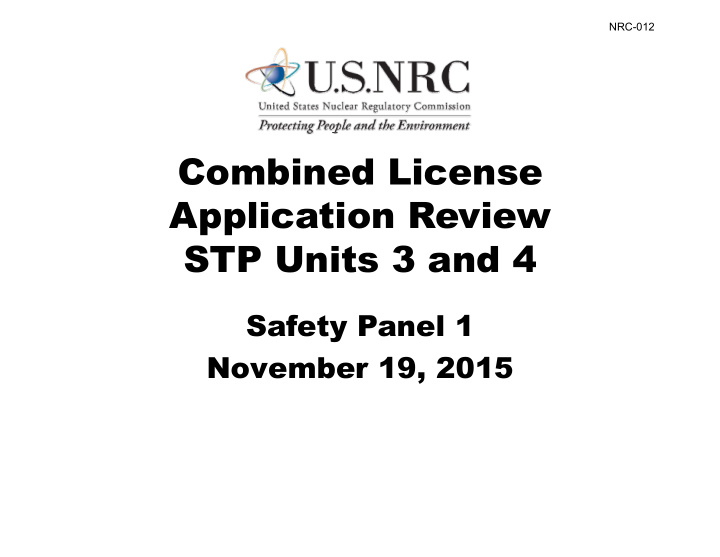



NRC-012 Combined License Application Review STP Units 3 and 4 Safety Panel 1 November 19, 2015
Panelists • Tom Tai – Senior Project Manager • Richard Turtil – Senior Financial Analyst • Dinesh Taneja – Senior Electronics Engineer 2
Departures Summary • Total departures – 275 • Departures – Tier 1, Tier 2*, Tier 2 and Technical Specifications (TS) • Tier 1, Tier 2*, and TS departures require NRC approval • Tier 2 departures generally do not require NRC approval 3
Tier 1 and TS Departures • Tier 1 departures – depart from certified portion of design • TS departures – depart from ABWR Technical Specifications • Exemptions are required for Tier 1 and TS departures 4
Tier 2* and Tier 2 Departures • Tier 2* departures require NRC approval but do not require an exemption • Tier 2 departures use 50.59-like change process • One Tier 2 departure required prior NRC approval 5
Tier 2 Departures • Staff confirmed it was reasonable that Tier 2 departures do not require NRC approval – Applied 50.59-like criteria – Examined applicant’s process – Some requests for additional information 6
Exemptions • Exemption request for material control and accounting • Exemption request for financial qualifications 7
Examples Covered In This Presentation • Exemption request – financial qualifications • Tier 1 departure – STD DEP 3.4-1, Safety Related I&C Architecture 8
Current Regulatory Framework for Financial Qualifications • Current requirements in 10 CFR 50.33(f) and Part 50, Appendix C • COL applicants must possess or have reasonable assurance of obtaining the funds to cover construction and operation costs 9
Challenges With Current Standard • Applicant could not meet current requirements and requested a more flexible approach • SECY-13-0124 provided policy options for Commission action 10
SRM on SECY-13-0124 • Change Part 50 by rulemaking to use Part 70 standard • Applicants can rely on license conditions • Consider granting exemptions during pendency of rulemaking, but exemptions must anticipate the outcome of the rulemaking 11
Draft Regulatory Basis • Draft Regulatory Basis addressed new Part 70 standard • Staff discussed draft proposed requirements with public and solicited comment • Comments supported change in financial qualification standard 12
Financial Capacity • Reflects applicant’s understanding of project size and scope • Is not a predictive finding that applicant will obtain financing • Supports staff’s determination that applicant appears to be financially qualified 13
NINA Exemption Request • NINA provided: – Reasonable cost estimates for construction and operation – Acceptable Financial Capacity Plan – License conditions ensuring adequate funding prior to construction and operation 14
NINA Exemption Request • NINA meets the proposed standards in the Draft Regulatory Basis • NINA satisfies the requirements for an exemption • NINA’s exemption request should be granted 15
Tier 1 Departure On I&C Architecture • Selection of digital instrumentation and control (I&C) platforms resulted in changes to I&C architecture • Data communication design changed the most 16
Tier 1 Departure On I&C Architecture • Diverse digital platforms are used for the Engineered Safety Features System and the Reactor Trip System • Changes enhance protection against failures 17
Tier 1 Departure On I&C Architecture • Review based on current regulations and staff guidance • Staff concluded the modified I&C design conforms with current requirements 18
Questions? 19
Backup Slides 20
Certified U.S. ABWR Ring Bus Design Actuator 1 RPS/MSIV to Ring Actuator N ECCS Bus Sensor 1 to SSLC/Trip Sensor N Representation of a Single Division 21
STP Point-to-Point Data Communication Design Actuator 1 SSLC/Trip to Actuator N Sensor 1 RPS/MSIV to ECCS Sensor N Representation of a Single Division 22
Recommend
More recommend